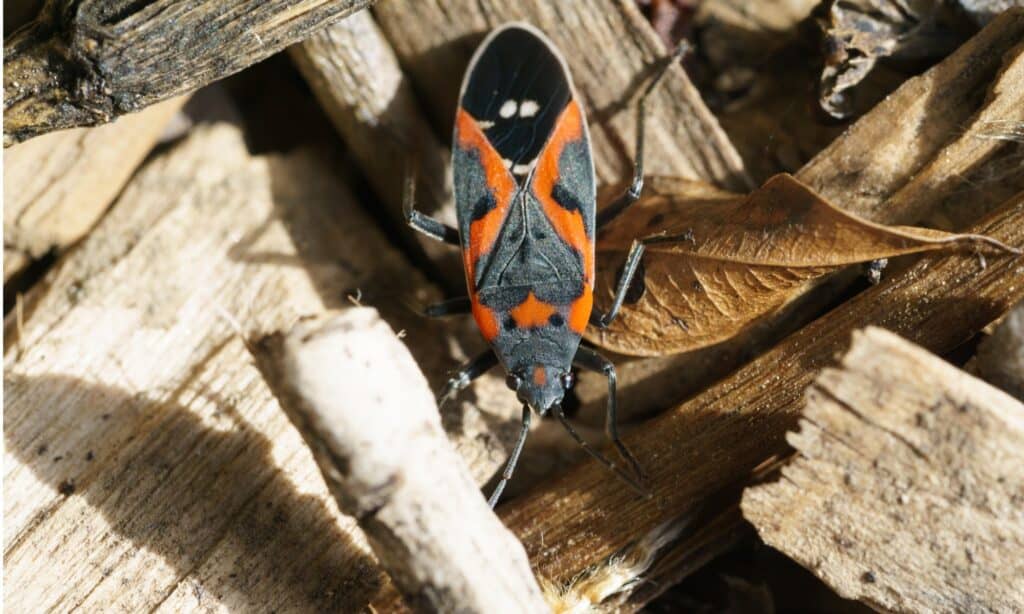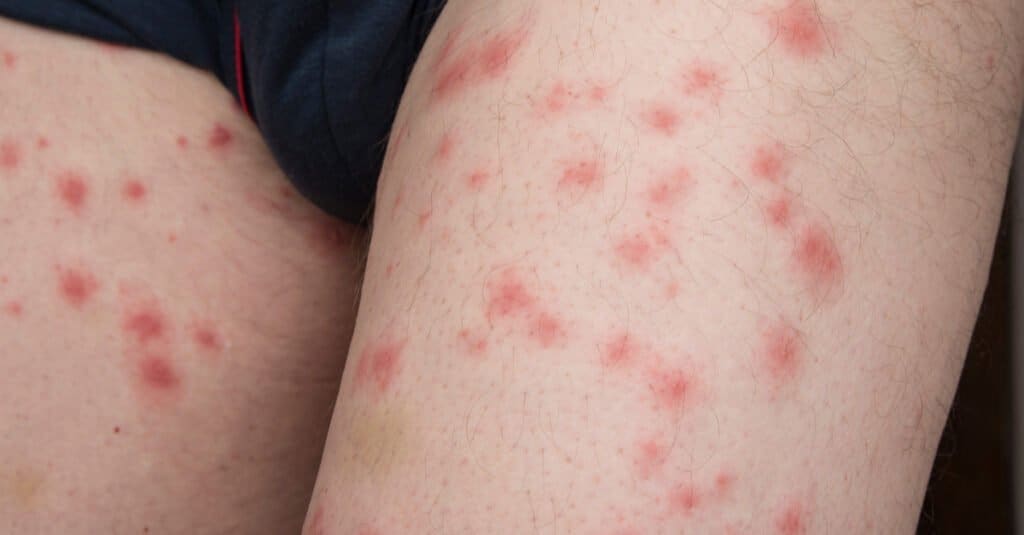Have you ever seen a boxelder maple tree and wondered why it was covered in black-and-red bugs? Those are the infamous boxelder bugs, Boisea trivittata, which are harmless yet notorious pests known for infesting homes. If you have the misfortune to live right next to a boxelder tree, you may be acquainted with its insect admirers and wonder what exactly they like to eat. Find out below what drives their appetite!
What Foods Do Boxelder Bugs Eat?

Boxelder bugs eat the seeds of the boxelder maple tree as well as tree leaves, plant juices, apples, and plums.
©iStock.com/ErikAgar
Boxelder bugs mainly eat the seeds of the boxelder maple tree, though they also eat other tree leaves, plant juices, and apples and plums. The boxelder tree is common in North America, especially in the western United States. However, it is also found in the eastern United States and adjoining portions of Canada as well as Mexico and Guatemala. Boxelder bugs can be found wherever this tree grows and therefore are a common North American pest.
When boxelder trees are in short supply, boxelder bugs will also seek out the ash and silver maple trees for their seeds and leaves. However, they are far less likely to be spotted around these trees.
A Complete List of 8 Foods Boxelder Bugs Eat

Boxelder bugs will feed on trees other than the boxelder maple if necessary. They supplement their diet with plant juices.
©iStock.com/Marina Denisenko
Boxelder bugs feed on boxelder seeds early in the spring when they first become active after the winter months. As the weather warms, the bugs move into female boxelder trees for the rest of the season. An outline of their diet is as follows:
- Boxelder seeds
- Boxelder tree leaves
- Ash tree leaves
- Silver maple tree leaves
- Sap
- Plant juices
- Apples
- Plums
Although they are pests, they cause no harm to the trees and therefore are not considered an ecological threat. Also, they are not like termites, which eat wood and cause damage to dwellings. Unlike many other insects, boxelder bugs are herbivorous, declining to eat other bugs. So, as far as their appetites go, they are neutral, doing neither harm nor good. This is good news for homeowners who worry that boxelder bugs may try to nibble at their houses.
What Eats the Boxelder Bug?
Rodents like mice, rats, and chipmunks will eat boxelder bugs given the chance. However, these animals are not a reliable method of population control as they do not eat large numbers of insects at a time. The boxelder bug is also not their meal of choice. They usually prefer a more lucrative meal and will look elsewhere if it is available.
Some other insects prey on boxelder bugs. For example, certain species of spiders will eat them. If a boxelder bug infestation is present, it’s a good idea to leave alone any spiderwebs you find. The praying mantis and wheel bug are also potential predators and very effectively dispatch their victims. The main problem with these insects and rodents, of course, is that most people don’t want them around. In fact, infestations of these creatures can be worse than the boxelder bugs themselves.
If the infestation occurs on a farm, chickens, ducks, and guinea hens may prove useful. All three of these fowls eat boxelder bugs, but they do so in limited quantities and only if their preferred food sources run short.
How to Identify the Boxelder Bug

Boxelder bugs are relatively flat insects about 0.5 inches long, with an oval body and six legs.
©iStock.com/fusaromike
Boxelder bugs are fairly easy to identify. They are relatively flat insects about 0.5 inches long, with an oval body and six legs. Their antennae are long and pronounced. The adults have wings with red piping, but the nymphs (young ones) are wingless and bright red. Adults are black, with red or orange piping.
One reason boxelder bugs don’t have many natural predators is their coloration. The red on their heads, wings, and abdomens signals to predators that they could be poisonous.
Habitat of the Boxelder Bug
Boxelder bugs like warm temperatures, a preference that drives their behavior throughout the year. As they are often found in regions with bitter winters, they have perfected the art of finding a way to survive. They come out of hiding in spring and immediately seek a food source. Eventually, they make their summer home in the boxelder, ash, or silver maple trees.
As autumn approaches, they congregate in sunny spots before moving indoors, usually into a building near their feeding grounds. For this reason, people who live close to boxelder trees may face persistent infestations of these bugs. Once they make their home in a human dwelling, they remain there until spring.
Do Boxelder Bugs Bite?

The mouthparts of a boxelder bug can puncture the skin and cause mild irritation, though not to the extent of the bed bug.
©OttoPles/Shutterstock.com
Technically, boxelder bugs don’t bite. However, similar to a mosquito, their mouthparts can puncture the skin and cause irritation. More troublesome is their tendency to gather in large groups in the fall as they seek shelter for the winter. As temperatures cool, homeowners may find their houses infested with massive numbers of boxelder bugs. They find relief from the cold by crawling into cracks and behind walls. In the case of an uncontrollable infestation, it’s best to deal with them by contacting a trained exterminator.
Fortunately, boxelder bugs are not known for causing damage to either property or vegetation. They do emit a foul odor if crushed and can stain fabric with their feces, but otherwise, they’re harmless. Other insect pests are of greater concern, such as bed bugs, which can cause skin rashes and stubbornly resist extermination. Some insects, like the house centipede, may be useful in curbing an infestation as they prey on bugs.
Can I Prevent an Infestation?
Unfortunately, it’s difficult to entirely prevent an infestation of boxelder bugs. They can travel long distances from their food sources to a house or other dwelling, meaning that you don’t have to have a boxelder tree right in your front yard to be affected. One possible solution is to remove female boxelder trees from the vicinity, but that is a drastic measure that is not guaranteed to work.
As already noted, various rodents and insects eat boxelder bugs, but they aren’t welcome in or around the home either. The best way to keep boxelder bugs out of the house is to seal windows and doors as well as any other cracks or openings in the house walls. If they do make it inside, a vacuum may work to remove them, at least in the short term. Outside the house, an insecticide sprayed on bushes or trees may help to kill the nymphs in spring. A professional exterminator may be able to provide assistance.
Boxelder bugs are annoying but mostly harmless inhabitants of the animal kingdom, provided you can keep them under control in your home.
The photo featured at the top of this post is © iStock.com/fusaromike
Thank you for reading! Have some feedback for us? Contact the AZ Animals editorial team.







